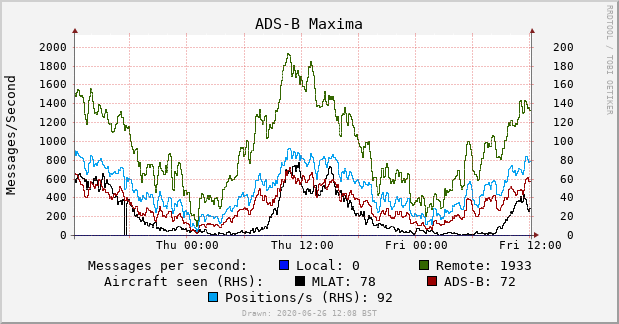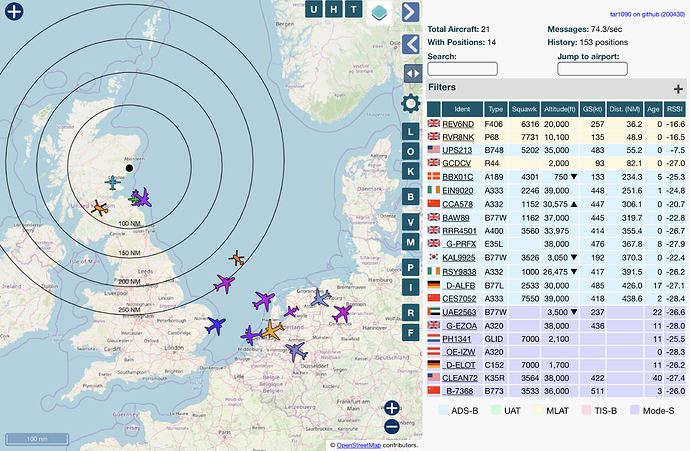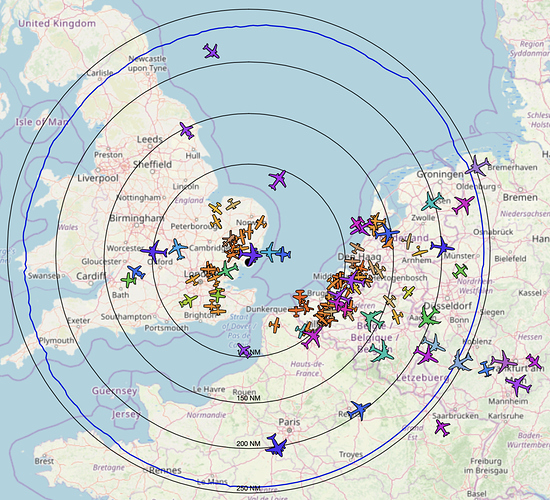That’s excellent, I’m seeing conditions slightly elevated but nothing at that sort of range.
It’s amazing how far ADSB travels given the right conditions! Glad it’s not affecting terrestrial TV here - I’ve seen weeks go by with Freeview badly affected.
Yeah, I’ve been seeing planes I don’t normally see. As far north as Glasgow & Edinburgh and as far south as the middle of the English Channel, which is kind of ‘over the horizon’ due to the houses south of me. Nothing like what you are seeing though.
But it is interesting that your reception seems to be best over water. Is that what’s known as ducting?
This is outside my sphere of knowledge for sure.
Hi @technodevotee - the other thing to look out for, other than increased range (as an indication for tropospheric ducting), is seeing aircraft lower then one would expect.
This morning I noticed an aircraft out to the west of UK at 243 miles distance from me, but it was at 23,400 ft. Normally for that sort of distance I’d expect to see it at 40,000 ft or more.
I calculated the elevation angle from my location and it was -0.73° which is well below my normal radio horizon for 1090Mhz on that bearing.
Yeah, I’ve noticed that as well. I’ve seen planes much lower in places where I’d normally lose them as soon as they’re below about 5000 feet.
@technodevotee Living at the foot of a hill on the coast, I lose nearly 180 degrees of coverage centered on the northwest. I suspect it is ducting and the effect can be quite directional, albeit predominantly to the south east for me or to the east where I see ground based beacons in Denmark.
It seems to happen when we get spells of high pressure. I also monitor ship positions via AIS and sometimes will also see vessels well outside my normal reception range.
As @hphillip mentioned, another feature is seeing craft much lower than usual at distance. I was seeing helicopters at a relatively low altitude near Amsterdam.
An interesting phenomenon!
I’ve always been envious of your reception range but that’s just showing off!
27 is the best I’ve seen for quite a while

After digging into how my different receivers, pi’s, and antennas each contribute to ADS-B reception, I have some observations I would like to make.
Antenna height has a direct effect on range. The FA antenna seems to work fine out 250NM and more. Next the cable to the Filter/Low Noise Amplifier (LNA)/receiver Dongle. Shorter quality cables have less loss. Do what makes sense to you in your situation. You can add a filter between the antenna and the LNA, but then you have lower levels of signals with the noise to be amplified. Generally, adding an amplifier before a filter results in better results because more desired signal with less noise is fed into the filter, with stronger signals for the coax run to the receiver dongle. In strong interference areas, putting the filter before the amplifier may help. Low loss filters like cavity filters are a big help, though more bulky and expensive. Every connection, cable, and adapter between the LNA/filter reduces the 1090Ghz signal before the receiver dongle demodulates and gives us the information used by Dump1090-xx. Each piece of the link from the antenna to the Pi, and even the Pi power supply affect how well this works. Noise can come from the power supplies whether a wall wort unit or a Power-over-Ethernet (POE) source. Even my hardwired Ethernet cables are a source of noise.
The net result, try to use a decent antenna, wire it with good cables and parts and have fun with this hobby. It is not rocket science, but from someone with long term RF communications and satellite background, this is about having fun, and perhaps continuing to tweak our systems to just be a bit better than before. There is no best way to do things in an RF environment, as each is different and the solution is to find a reasonable medium. Thanks for wading through this monologue.
That’s true. I’ve played around with some elevation values on heywhatsthere.com and the range is impacted directly
I agree with this 100% ![]() and it’s exactly how I’ve built my setup.
and it’s exactly how I’ve built my setup.
I’ve been a radio ham for nearly forty years now and this is how my station and aerials have been migrated and tweaked throughout the years. I’m not a big gun but I’m not a little pistol any more either, I’m somewhere in-between ![]()
i think its avoiding me
never seem to go over the lines
Getting good reception over the last two days.
Even AIS frequences (162MHz) are doing realy well with vessels out at 160NM!
Not seeing much enhancement on 1090MHz at the moment but an MM0 (three miles south of Peterhead) has just called into our local repeater in Clacton-on-Sea on 70cms.
Got some nice tropo over the Baltic sea earlier tonight. Got some hits 265 nautical miles away from my station and about 15 aircrafts at 250-255 NM. I usually top out at 240 NM.
Today I’m seeing helicopters over Denmark at 1100ft AGL at a distance of over 350nm. Yeah, conditions are up.
Certainly is I’ve had regular contacts over Germany of 350NM today
My peak message rates are 500 per second lower than yesterday!
Amazing difference in conditions:






